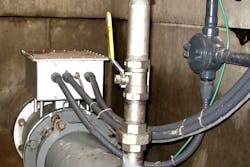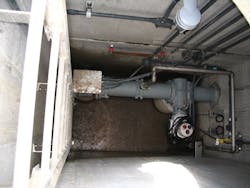The City of Pottsville in Schuylkill County, Pa., faced a serious problem with wastewater overflows, caused in part by the design of its 1800s-era masonry sewers. For many years, raw sewage transported by the 4-ft pipes emptied directly into a creek. In the 1970s, the city installed an interceptor to collect a portion of the flow and send it to the recently built wastewater treatment plant.
Although that remedied some of the problem, the combined sanitary/storm sewer system had a flaw. After a large rainstorm, the interceptor would overwhelm the treatment plant with storm water and the plant would flood, sending untreated or partially treated water into streams. That led to fines from the state regulatory agency and negative impacts on the environment. The key to a solution would be to regulate the initial flow of water into the interceptor system. The city found the answer in partially filled magmeters that measure flows and enable the staff to determine when to divert water away from the treatment plant during rain events.
Measuring Flows
To design a viable solution, the city turned to the Buchart Horn engineering and architectural firm in York, Pa. The firm began by updating the city’s 537 Plan, required under the Pennsylvania Sewage Facilities Act, which was enacted in 1966.
“The 537 Plan is approved by the Pennsylvania Department of Environmental Protection,” said Bruce Hulshizer, a senior engineer with Buchart Horn and a project manager for sewer and water projects. “That’s basically saying ‘This is what we’re going to do for our sewer needs.’ Apparently, the DEP wasn’t satisfied with the way things were going, and the city wasn’t going to meet the consent order, so the city staff pulled us in.”
As part of the solution, Buchart Horn brought in KROHNE, which offers measurement instrumentation for wastewater treatment and process industries. The company recommended partially filled electromagnetic flowmeters (magmeters).
By using these magmeters, the city can measure the normal dry-weather flows that would not keep a typical magmeter filled, as well as the higher wet-weather flows. Using the flow data, the city could divert wet-weather storm water flows away from the treatment plant and directly into waterways, preventing plant overload. Flows above a preset rate are assumed to consist mainly of relatively clean storm water runoff that can be safely discharged to the environment. When normal flow rates resume, the flow is directed back to the treatment plant.
Repeatable Results
“The city had a combined system,” said Hulshizer. “In order to have such a system, you must have control structures that basically separate sanitary flow from a pre-designated amount of flow. Above that level, it would be storm flow, so you’d have to have some way of dividing the two. That’s where the partially filled magmeters came in.”
The electromagnetic flowmeters contain electronics designed to provide reliable and repeatable results, even under difficult conditions. The units are wet-calibrated by direct comparison of volumes, the most accurate calibration method, to achieve accuracy to ±0.2% of actual value.
For the Pottsville project, Buchart Horn chose 21 Tidalflux electromagnetic magmeters, combined with a capacitive flow-level measuring system built into the wall of the measuring tube. This provides accurate flow measurements in pipelines filled to levels from 10% to 100% of the pipe cross-section. The flowmeters are factory-calibrated to ensure high accuracy in partially filled pipelines. They are designed with abrasion and chemical resistance to achieve steady display of measured values regardless of rough surfaces and distorted flow profiles.
Impacts Reduced
The city benefitted from KROHNE’s installation base for use as a reference for the performance of partially filled magmeters. In the end, the load on the wastewater treatment plant was substantially reduced in high-water events, allowing the plant to operate within its specified ranges. The impacts of untreated or undertreated wastewater discharges were also reduced.
“It’s been a long process to where the city has come in terms of its wastewater treatment, but it has been a very effective solution,” said Hulshizer.

